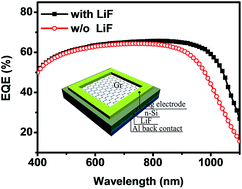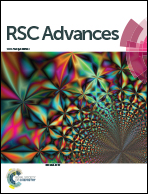Interface engineering and efficiency improvement of monolayer graphene–silicon solar cells by inserting an ultra-thin LiF interlayer†
Abstract
Graphene–silicon (Gr–Si) Schottky junction solar cells have recently attracted intensive attention as candidates for low-cost photovoltaic devices. However, the efficiency of Gr–Si solar cells still needs further improvement. In this study, we have introduced an ultra-thin LiF layer between the Si and aluminum (Al) back electrode of Gr–Si solar cells. It is found that carrier recombination at the back surface is significantly suppressed, resulting directly in the improvement of external quantum efficiency (EQE) of devices in the long wavelength range of 800–1100 nm. Moreover, the back contact resistance is greatly reduced, and therefore the fill factor (FF) of devices is greatly improved. As a result, the highest power conversion efficiency (PCE) of 6.25% has been obtained for a pristine Gr–Si solar cell, which is further improved to 10.61% after chemical doping. These results pave a new way to the fabrication of high efficiency Gr–Si solar cells.


 Please wait while we load your content...
Please wait while we load your content...